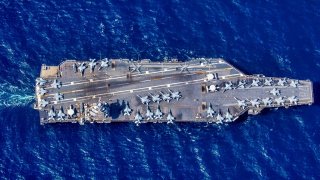The Navy's Ford-Class Aircraft Carriers: Floating Air Bases with Lots of Problems
The U.S. Navy's Ford-class aircraft carriers are facing significant delays and cost overruns, attributed largely to ambitious technological integrations and recent supply chain disruptions.
Summary: The U.S. Navy's Ford-class aircraft carriers are facing significant delays and cost overruns, attributed largely to ambitious technological integrations and recent supply chain disruptions.
-Initiated with 23 new technologies, including the notable Electromagnetic Aircraft Launch System (EMALS), these carriers have encountered numerous challenges in systems integration, impacting their scheduled deployment. Navy Secretary Carlos Del Toro's recent review highlighted these issues, which have pushed the delivery of the USS Enterprise (CVN-80) to as late as 2030.
-The introduction of such advanced technologies, while aiming to enhance operational capabilities, has escalated costs substantially, with the program exceeding initial projections by $40 billion as of 2023.
Ford-Class Aircraft Carriers: Innovation Overrun Leads to Delays and Budget Surges
Nothing has gone smoot for the Ford-Class aircraft carriers since their inception. The U.S. Navy’s newest aircraft carrier class faces delays that could push back deliveries of future ships into the next decade.
As detailed in a thorough review ordered by Navy Secretary Carlos Del Toro earlier this year, supply chain issues and other lingering consequences of the pandemic are to blame. Further, as the Navy’s newest carriers, Ford-class ships incorporate a wide array of untested technologies. The challenge of successfully integrating these systems is another factor pushing back the Ford class's introduction to service.
The third Ford-class carrier planned for construction – the USS Enterprise (CVN-80) – is planned to be delivered to the service in 2030 at the latest.
Ford-Class: Too Many New Technologies?
In 2011, Chief of Naval Operations Adm. Mike Gilday admitted that the Navy might have been overly ambitious when designing the Ford class, cramming the vessels with a number of new and uncharted systems.
"We had 23 new technologies on that ship, which quite frankly increased the risk … of delivery on time and cost right from the get-go." Gilday said, adding that "we really shouldn't introduce more than maybe one or two new technologies on any complex platform like that in order to make sure that we keep risk at a manageable level.”
The Ford class’s electromagnetic aircraft launch system, or EMALS, is perhaps its most recognizable new technology. A departure from the steam-operated Nimitz-class carriers, this system promises higher sortie generation rates, among other improvements. However, in 2020 EMALS’ reliability numbers were running far below expectations. In addition to EMALS, issues surrounding the Ford’s deflectors and Advanced Arresting Gear have also prolonged the class’s timely introduction to service.
Too High a Cost for these Aircraft Carriers?
Equipped with all these cutting-edge technologies, the Ford class is exorbitantly expensive. Each ship in the series costs $13 billion to produce and maintain. By 2023, the program had cost the Navy roughly $120 billion, which is about $40 billion more than the initial cost projection.
The class requires more than 5,000 shipbuilders to work an estimated 49 million hours to build each ship, according to a video published by Business Insider last year. The new technologies on board the ships certainly drive up these costs. For instance, researching and testing the EMALS cost $1 billion dollars alone, in addition to the system's $670 million installation.

Supply Chain Issues?
As mentioned earlier, supply chain issues are also playing a role in the Ford class’s late delivery. The president of Huntington Ingalls noted that delays to a number of specific parts are to blame. The Navy’s Columbia-class and Virginia-class Block IV submarines are also suffering from supply chain issues.
About the Author: Maya Carlin
Maya Carlin, National Security Writer with The National Interest, is an analyst with the Center for Security Policy and a former Anna Sobol Levy Fellow at IDC Herzliya in Israel. She has by-lines in many publications, including The National Interest, Jerusalem Post, and Times of Israel. You can follow her on Twitter: @MayaCarlin.
Image Credit: U.S. Navy.


